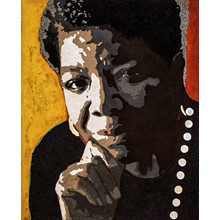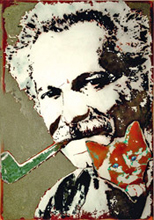![]()
|
||||||||
| PEOPLE | |||
|---|---|---|---|
|
|
|||
|
Is there still any sense in painting the human figure and in particular portraits?
|
 Maya Angelou |
|
|
|
specular portrait of Antonin Artaud
|
|
|
|
|
< In the last century, the focus of art shifted from illusionist representation to independent objectivity. The contemporary notion of painting is of an autonomous entity that has no other need than to assert its own existence, with no reference to visible reality. Artworks are built to exist by themselves, with no need to look like or represent any other object. A painting interacts with the sight of the observer and from this dialogue without words is born a non-intellectual awareness.
|
|
|
|
|
|
|
|
|
|
Playing with sand, lime and mineral pigments, the basic elements in the art of fresco painting, I posed myself questions on the essence of color and on the meaning of the very act of painting in contemporary society. |
|
|
 George Brassens with pipe and cat |
|
|
|
| In Minimal fresco the sand and lime mortar are not used simply as a base but the different varieties are used as colours and textures in themselves, while the distinctive element of materic fresco is the thick layers of pre-coloured mortar, which are applied with a palette knife. Working in this way, the process of building the image becomes the subject of the work as much as the subject represented. Transferring a portrait onto a large format means that the subject is never seen in its totality; the portrait is produced by working on small pieces without seeing the whole image. Difficulties of this kind are crucial to define the nature of the image that will be built up through a process. Renaissance fresco painters solved this problem through the cartoni and spolvero technique (cartoon and pouncing). |
|||
|
|||
| The cartoni technique is a procedural one because it gives priority to the process and defines the steps of the work before doing them. Transferring an image on cartoons is a rigorous and limiting process. The constructive process prevails on the subject that, to some extent, becomes anonymous, in spite of the fact that it has a name. The subject assumes a secondary role in respect to the method of constructing the image and the division of the face into single parts and their subsequent resetting together, in order to restore the whole, does not produce a loss of description; the portrayed person is always recognizable. Marking distinctions between observed phenomena, identifying relational schemes and drawing their maps are characteristics of the human mind. Since the most ancient of times, the continuous and unstoppable activity of the human mind has been to introduce distinctions in the phenomena that we observe, characterized by a sensibility to the differences, in particular to the difference that produces a difference, which we call information, and consists in characterizing patterns of relationships and constructing their relative maps. If the construction of maps is inborn in the nature of the mental processes of the human being, the mental processes, to be able to manifest themselves, need to be structured in matter and this helps us to relate the measure of man to that of the known universe. From this point of view, I like to look at a human face as a territory and painting as a process to draw a map of that territory, having it clear in my mind that the map is not the territory, the description is not the described, and the name is not the thing named. |
Rabindranath Tagore |
||
|
|||